 |
OLD HOSPITALS AND ALMSHOUSES |
| << OLD BRIDGES |
| VANISHING FAIRS >> |
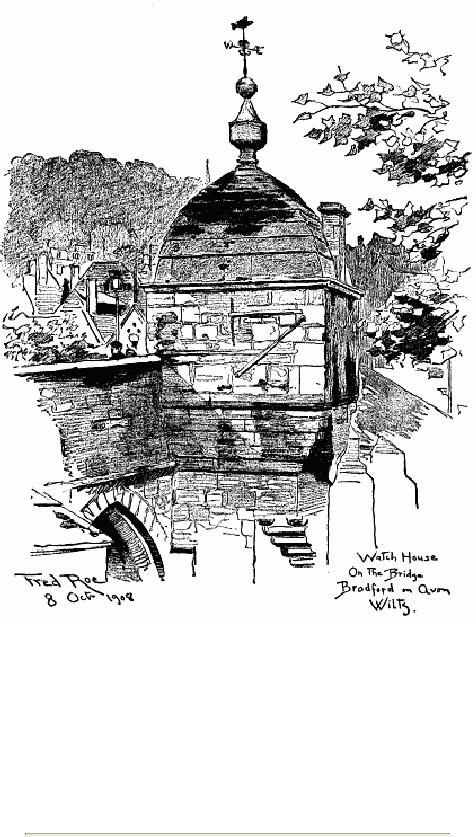
Watch
House On The Bridge Bradford
on Avon Wilts
The
study of the bridges of England
seems to have been somewhat
neglected by
antiquaries.
You will often find some good
account of a town or village in
guide-
books
or topographical works, but
the story of the bridges is
passed over in
silence.
Owing
to the reasons we have
already stated, old bridges
are fast disappearing and
are
being substituted by the
hideous erections of iron
and steel. It is well that
we
should
attempt to record those that
are left, photograph them
and paint them, ere
the
march
of modern progress, evinced by the
traction-engine and the motor-car,
has
quite
removed and destroyed
them.
CHAPTER
XV
OLD
HOSPITALS AND ALMSHOUSES
There
are in many towns and
villages hospitals--not the
large modern and
usually
unsightly
buildings wherein the sick
are cured, with wards
all spick and span
and
up
to date--but beautiful old
buildings mellowed with age
wherein men and
women,
on whom the snows of life
have begun to fall thickly,
may rest and recruit
and
take their ease before they
start on the long, dark
journey from which no
traveller
returns to tell to those he left
behind how he fared.
Almshouses
we usually call them now,
but our forefathers
preferred to call
them
hospitals,
God's hostels, "God huis,"
as the Germans call their
beautiful house of
pity
at L�beck, where the
tired-out and money-less folk
might find harbourage.
The
older
hospitals were often called
"bede-houses," because the inmates
were bound to
pray
for their founder and
benefactors. Some medieval
hospitals, memorials of
the
charity
of pre-Reformation Englishmen, remain,
but many were suppressed
during
the
age of spoliation; and others
have been so rebuilt and
restored that there is
little
left
of the early
foundation.
We
may notice three classes of
these foundations. First,
there are the
pre-
Reformation
bede-houses or hospitals; the
second group is composed of
those
which
were built during the
spacious days of Queen Elizabeth,
James I, and Charles
I.
The Civil War put a stop to
the foundation of almshouses. The
principal
landowners
were impoverished by the war
or despoiled by the Puritans, and
could
not
build; the charity of the
latter was devoted to other purposes.
With the
Restoration
of the Church and the
Monarchy another era of the
building of
almshouses
set in, and to this period
very many of our existing
institutions belong.
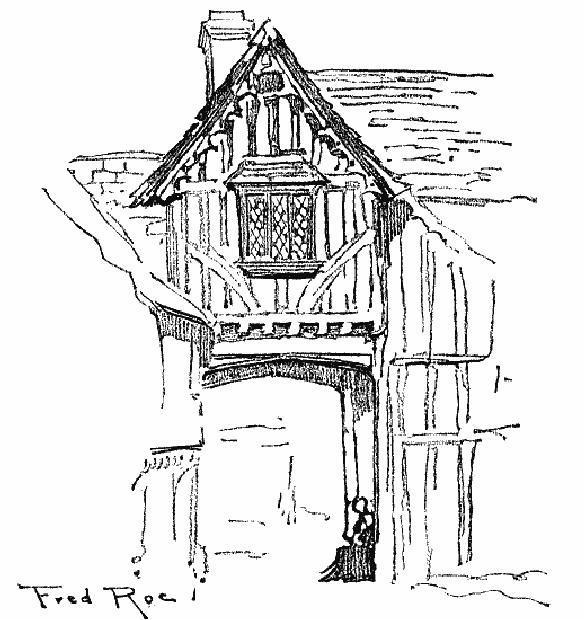
Gateway
of St. John's Hospital,
Canterbury
Of
the earliest group we have
several examples left. There
is the noble hospital
of
St.
Cross at Winchester, founded in
the days of anarchy during
the contest between
Stephen
and Matilda for the
English throne. Its
hospitable door is still
open. Bishop
Henry
of Blois was its founder, and he
made provision for thirteen
poor men to be
housed,
boarded, and clothed, and for a hundred
others to have a meal every
day.
He
placed the hospital under
the care of the Master of
the Knights
Hospitallers.
Fortunately
it was never connected with a
monastery. Hence it escaped
pillage and
destruction
at the dissolution of monastic houses.
Bishop Henry was a great
builder,
and
the church of the hospital
is an interesting example of a structure
of the
Transition
Norman period, when the
round arch was giving
way to the Early
English
pointed arch. To this
foundation was added in 1443 by
Cardinal Beaufort
an
extension called the
"Almshouse of Noble Poverty," and it is
believed that the
present
domestic buildings were
erected by him.58
The
visitor can still obtain
the
dole
of bread and ale at the gate of
St. Cross. Winchester is well
provided with old
hospitals:
St. John's was founded in 931 and
refounded in 1289; St.
Mary
Magdalen,
by Bishop Toclyve in 1173-88
for nine lepers; and
Christ's Hospital in
1607.
We
will visit some less
magnificent foundations. Some
are of a very simple
type,
resembling
a church with nave and
chancel. The nave part was a
large hall divided
by
partitions on each side of an
alley into little cells in
which the bedesmen
lived.
Daily
Mass was celebrated in the chancel, the
chapel of hospital, whither
the
inmates
resorted; but the sick and
infirm who could not
leave their cells were
able
to
join in the service. St.
Mary's Hospital, at Chichester, is an
excellent example, as
it
retains its wooden cells,
which are still used by
the inmates. It was formerly
a
nunnery,
but in 1229 the nuns
departed and the almswomen
took their place. It is of
wide
span with low side-walls,
and the roof is borne by
wooden pillars. There
are
eight
cells of two rooms each, and
beyond the screen is a
little chapel, which is
still
used
by the hospitallers.59
Archbishop
Chichele founded a
fine hospital at
Higham Ferrers in
Northamptonshire,
which saw his lowly birth,
together with a school and
college,
about
the year 1475. The
building is still in existence and
shows a good roof and
fine
Perpendicular window, but
the twelve bedesmen and the
one sister, who was to
be
chosen for her plainness, no
longer use the
structure.
Stamford
can boast of a fine medieval
hospital, the foundation of
Thomas Browne
in
1480 for the accommodation of
ten old men and two
women. A new
quadrangle
has
been built for the
inmates, but you can
still see the old
edifice with its nave
of
two
storeys, its fifteenth-century stained
glass, and its chapel with
its screen and
stalls
and altar.
Stamford
has another hospital which
belongs to our second group.
Owing to the
destruction
of monasteries, which had been great benefactors to
the poor and
centres
of vast schemes of charity,
there was sore need for
almshouses and other
schemes
for the relief of the
aged and destitute. The
nouveaux
riches, who
had
fattened
on the spoils of the monasteries,
sought to salve their
consciences by
providing
for the wants of the
poor, building grammar
schools, and doing
some
good
with their wealth. Hence
many almshouses arose during
this period. This
Stamford
home was founded by the great
Lord Burghley in 1597. It is a
picturesque
group
of buildings with tall
chimneys, mullioned and dormer
windows, on the bank
of
the Welland stream, and occupies the site
of a much more ancient
foundation.
There
is the college at Cobham, in
Kent, the buildings forming
a pleasant
quadrangle
south of the church. Flagged
pathways cross the
greensward of the
court,
and there is a fine hall
wherein the inmates used to
dine together.
As
we traverse the village
streets we often meet with
these grey piles of
sixteenth-
century
almshouses, often low, one-storeyed
buildings, picturesque and
impressive,
each
house having a welcoming porch
with a seat on each side and
a small garden
full
of old-fashioned flowers. The
roof is tiled, on which moss
and lichen grow, and
the
chimney-stacks are tall and
graceful. An inscription records the
date and name
of
the generous founder with
his arms and motto. Such a
home of peace you
will
find
at Quainton, in Buckinghamshire, founded,
as an inscription records, "Anno
Dom.
1687. These almshouses were then
erected and endow'd by
Richard
Winwood,
son and heir of Right Hon'ble
Sir Ralph Winwood, Bart.,
Principal
Secretary
of State to King James y'e
First." Within these walls
dwell (according to
the
rules drawn up by Sir Ralph
Verney in 1695) "three poor
men--widowers,--to
be
called Brothers, and three
poor women--widows,--to be called
Sisters." Very
strict
were these rules for
the government of the almshouses, as to
erroneous
opinions
in any principle of religion,
the rector of Quainton being
the judge, the
visiting
of alehouses, the good conduct of the
inmates, who were to be
"no
whisperers,
quarrelers, evil speakers or
contentious."
These
houses at Quainton are very
humble abodes; other almshouses
are large and
beautiful
buildings erected by some
rich merchant, or great noble, or
London City
company,
for a large scheme of
charity. Such are the
beautiful almshouses in the
Kingsland
Road, Shoreditch, founded in the
early part of the eighteenth
century
under
the terms of the will of Sir
Robert Geffery. They stand in a garden
about an
acre
in extent, a beautiful oasis in
the surrounding desert of warehouses,
reminding
the
passer-by of the piety and
loyal patriotism of the great
citizens of London, and
affording
a peaceful home for many
aged folk. This noble
building, of great
architectural
dignity, with the figure of
the founder over the
porch and its garden
with
fine trees, has only just
escaped the hands of the
destroyer and been
numbered
among
the bygone treasures of
vanished England. It was seriously
proposed to pull
down
this peaceful home of poor
people and sell the valuable
site to the Peabody
Donation
Fund for the erection of
working-class dwellings. The almshouses
are
governed
by the Ironmongers' Company, and
this proposal was made; but,
happily,
the
friends of ancient buildings
made their protest to the
Charity Commissioners,
who
have refused their sanction
to the sale, and the
Geffery Almshouses will
continue
to exist, continue their
useful mission, and remain
the chief
architectural
ornament
in a district that sorely
needs "sweetness and light."
City
magnates who desired to
build and endow hospitals
for the aged nearly
always
showed
their confidence in and affection
for the Livery Companies to
which they
belonged
by placing in their care
these charitable foundations.
Thus Sir Richard
Whittington,
of famous memory, bequeathed to
the Mercers' Company all
his
houses
and tenements in London, which
were to be sold and the
proceeds
distributed
in various charitable works.
With this sum they
founded a College of
Priests,
called Whittington College,
which was suppressed at the
Reformation, and
the
almshouses adjoining the old
church of St. Michael
Paternoster, for
thirteen
poor
folk, of whom one should be
principal or tutor. The
Great Fire destroyed
the
buildings;
they were rebuilt on the
same site, but in 1835 they
were fallen into
decay,
and the company re-erected them at
Islington, where you will
find
Whittington
College, providing accommodation
for twenty-eight poor
women.
Besides
this the Mercers have charge
of Lady Mico's Almshouses at
Stepney,
founded
in 1692 and rebuilt in 1857, and the
Trinity Hospital at
Greenwich,
founded
in 1615 by Henry Howard, Earl of
Northampton. This earl was of a
very
charitable
disposition, and founded other
hospitals at Castle Rising in Norfolk
and
Clun
in Shropshire. The Mercers
continue to manage the
property and have built
a
new
hospital at Shottisham, besides
making grants to the others
created by the
founder.
It is often the custom of
the companies to expend out of
their private
income
far more than they
receive from the funds of
the charities which
they
administer.
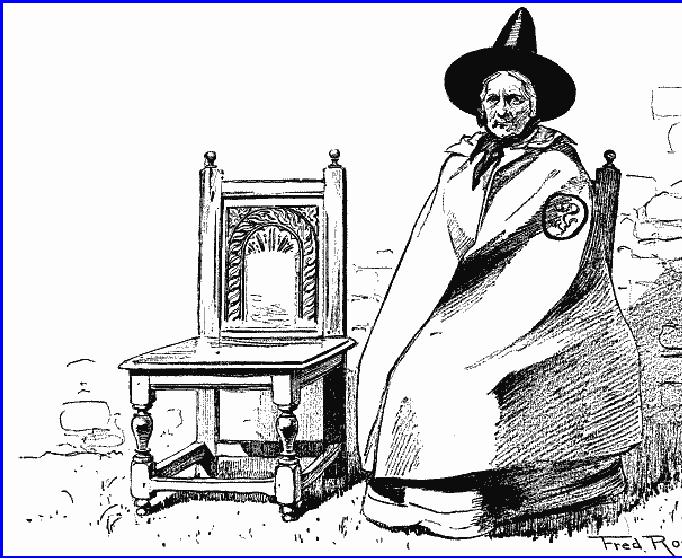
Inmate
of the Trinity Bede House at
Castle Rising, Norfolk
The
Grocers' Company have almshouses and a
Free Grammar School at
Oundle in
Northamptonshire,
founded by Sir William
Laxton in 1556, upon which
they have
expended
vast sums of money. The Drapers
administer the Mile End
Almshouses
and
school founded in 1728 by Francis
Bancroft, Sir John Jolles's almshouses
at
Tottenham,
founded in 1618, and very
many others. They have
two hundred in the
neighbourhood
of London alone, and many
others in different parts of the
country.
Near
where I am writing is Lucas's Hospital at
Wokingham, founded by
Henry
Lucas
in 1663, which he placed in the charge of
the company. It is a
beautiful
Carolian
house with a central portion and
two wings, graceful and
pleasing in every
detail.
The chapel is situated in one
wing and the master's house in
the other, and
there
are sets of rooms for
twelve poor men chosen from
the parishes in the
neighbourhood.
The Fishmongers have the
management of three important
hospitals.
At Bray, in Berkshire, famous
for its notable vicar,
there stands the
ancient
Jesus Hospital, founded in 1616
under the will of William
Goddard, who
directed
that there should be built
rooms with chimneys in the
said hospital, fit
and
convenient
for forty poor people to
dwell and inhabit it, and
that there should be
one
chapel or place convenient to serve
Almighty God in for ever
with public and
divine
prayers and other exercises of
religion, and also one kitchen and
bakehouse
common
to all the people of the
said hospital. Jesus
Hospital is a quadrangular
building,
containing forty almshouses surrounding a
court which is divided
into
gardens,
one of which is attached to each house.
It has a pleasing entrance
through
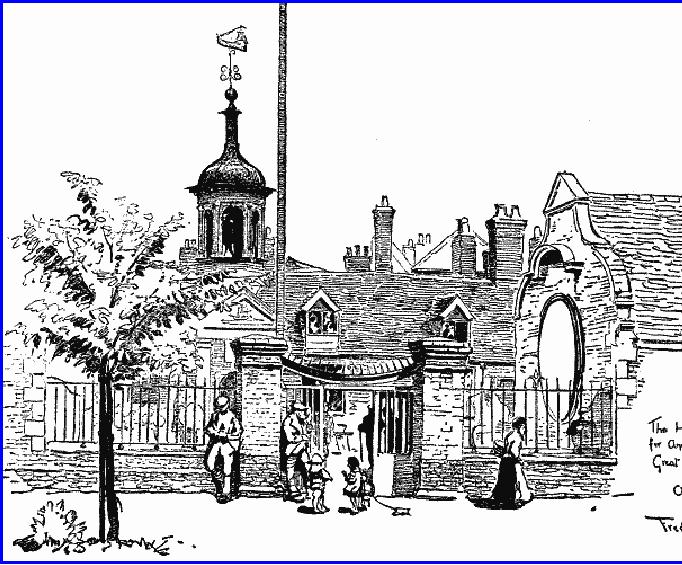
a
gabled brick porch which has
over the Tudor-shaped
doorway a statue of the
founder
and mullioned latticed windows.
The old people live happy
and contented
lives,
and find in the eventide of
their existence a cheerful home in
peaceful and
beautiful
surroundings. The Fishmongers also
have almshouses at Harrietsham, in
Kent,
founded by Mark Quested, citizen and
fishmonger of London, in 1642,
which
they
rebuilt in 1772, and St.
Peter's Hospital, Wandsworth,
formerly called the
Fishmongers'
Almshouses. The Goldsmiths
have a very palatial pile of
almshouses
at
Acton Park, called Perryn's
Almshouses, with a grand
entrance portico, and
most
of
the London companies provide in
this way homes for their
decayed members, so
that
they may pass their
closing years in peace and freedom
from care.
The
Hospital for Ancient
Fishermen, Great
Yarmouth.
Fishermen,
who pass their lives in
storm and danger reaping the
harvest of the sea,
have
not been forgotten by pious
benefactors. One of the most
picturesque
buildings
in Great Yarmouth is the
Fishermen's Hospital, of which we
give some
illustrations.
It was founded by the corporation of
the town in 1702 for
the
reception
of twenty old fishermen and
their wives. It is a charming house of
rest,
with
its gables and dormer
windows and its general air
of peace and repose. The
old
men
look very comfortable after
battling for so many years
with the storms of
the
North
Sea. Charles II granted to
the hospital an annuity of �160
for its support,
which
was paid out of the excise on beer,
but when the duty was
repealed the
annuity
naturally ceased.
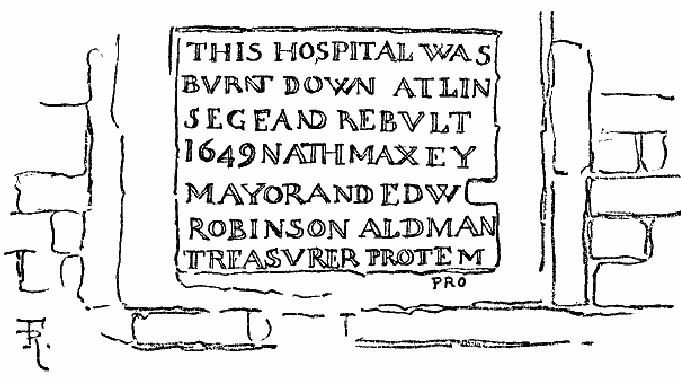
The
old hospital at King's Lynn was
destroyed during the siege,
as this quaint
inscription
tells:--
THIS
HOSPITAL WAS
BURNT
DOWN AT LIN
SEGE
AND REBULT
1649
NATH MAXEY
MAYOR
AND EDW
ROBINSON
ALDMAN
TREASURER
PRO TEM
P.R.O.
Norwich
had several important hospitals.
Outside the Magdalen gates
stood the
Magdalen
Hospital, founded by Bishop
Herbert, the first bishop.
It was a house for
lepers,
and some portions of the
Norman chapel still exist in
a farm-building by the
roadside.
The far-famed St. Giles's
Hospital in Bishopsgate Street is an
ancient
foundation,
erected by Bishop Walter
Suffield in 1249 for poor
chaplains and other
poor
persons. It nearly vanished at
the Reformation era, like so
many other kindred
institutions,
but Henry VIII and Edward VI
granted it a new charter.
The poor
clergy
were, however, left out in
the cold, and the benefits
were confined to
secular
folk.
For the accommodation of its
inmates the chancel of the
church was divided
by
a floor into an upper and a
lower storey, and this
arrangement still exists,
and
you
can still admire the
picturesque ivy-clad tower,
the wards with cosy
ingle-
nooks
at either end and cubicles
down the middle, the
roof decorated with
eagles,
deemed
to be the cognizance of Queen
Anne of Bohemia, wife of
Richard II, the
quaint
little cloister, and above all,
the excellent management of
this grand
institution,
the "Old Man's Hospital," as
it is called, which provides
for the
necessities
of 150 old folk, whose wants
are cared for by a master
and twelve
nurses.
Inscription
on the Hospital, King's
Lynn
Let
us travel far and visit
another charming almshouse,
Abbot's Hospital, at
Guildford,
which is an architectural gem and worthy
of the closest inspection. It
was
founded by Archbishop Abbot in
1619, and is a noble building of
mellowed
brick
with finely carved oak doors,
graceful chimneys with their
curious "crow-
rests,"
noble staircases, interesting
portraits, and rare books,
amongst which is a
Vinegar
Bible. The chapel with
its Flemish windows showing
the story of Jacob
and
Esau, and oak carvings and
almsbox dated 1619, is
especially attractive.
Here
the
founder retired in sadness and
sorrow after his unfortunate
day's hunting in
Bramshill
Park, where he accidentally shot a
keeper, an incident which
gave
occasion
to his enemies to blaspheme and deride
him. Here the Duke of
Monmouth
was
confined on his way to
London after the battle of
Sedgemoor. The details of
the
building are worthy of
attention, especially the
ornamented doors and
doorways,
the elaborate latches, beautifully
designed and furnished with a
spring,
and
elegant casement-fasteners. Guildford
must have had a school of great
artists of
these
window-fasteners. Near the
hospital there is a very
interesting house, No.
25
High
Street, now a shop, but
formerly the town clerk's
residence and the
lodgings
of
the judges of assize; no
better series in England of
beautifully designed
window-
fasteners
can be found than in this
house, erected in 1683; it also
has a fine
staircase
like that at Farnham Castle,
and some good plaster
ceilings resembling
Inigo
Jones's work and probably done by
his workmen.
The
good town of Abingdon has a
very celebrated hospital founded in 1446
by the
Guild
of the Holy Cross, a
fraternity composed of "good
men and true,"
wealthy
merchants
and others, which built the
bridge, repaired roads, maintained a
bridge
priest
and a rood priest, and held a great
annual feast at which the
brethren
consumed
as much as 6 calves, 16 lambs, 80 capons,
80 geese, and 800 eggs. It
was
a
very munificent and beneficent
corporation, and erected these almshouses
for
thirteen
poor men and the same
number of poor women. That
hospital founded so
long
ago still exists. It is a
curious and ancient structure in one
storey, and is
denoted
Christ's Hospital. One of
our recent writers on
Berkshire topography,
whose
historical accuracy is a little open to
criticism, gives a good description
of
the
building:--
"It
is a long range of chambers built of
mellow brick and
immemorial
oak, having in their centre
a small hall, darkly
wainscoted,
the very table in which
makes a collector
sinfully
covetous.
In front of the modest doors of the
chambers
inhabited
by almsmen and almswomen runs a
tiny cloister with
oak
pillars, so that the inmates
may visit one another
dryshod in
any
weather. Each door, too,
bears a text from the
Old or New
Testament.
A more typical relic of the
old world, a more
sequestered
haven of rest, than this
row of lowly
buildings,
looking
up to the great church in front, and
with its windows
opening
on to green turf bordered with flowers in
the rear, it
could
not enter into the
heart of man to imagine."
60
We
could spend endless time in
visiting the old almshouses in
many parts of the
country.
There is the Ford's Hospital in
Coventry, erected in 1529, an
extremely
good
specimen of late Gothic work,
another example of which is
found in St. John's
Hospital
at Rye. The Corsham
Almshouses in Wiltshire, erected in
1663, are most
picturesque
without, and contain some
splendid woodwork within,
including a fine
old
reading-desk with carved seat in
front. There is a large
porch with an immense
coat-of-arms
over the door. In the
region of the Cotswolds,
where building-stone is
plentiful,
we find a noble set of almshouses at
Chipping Campden in
Gloucestershire,
a gabled structure near the church
with tall, graceful chimneys
and
mullioned
windows, having a raised
causeway in front protected by a
low wall.
Ewelme,
in Oxfordshire, is a very attractive
village with a row of
cottages half a
mile
long, which have before
their doors a sparkling stream dammed
here and there
into
watercress beds. At the top of
the street on a steep knoll stand
church and
school
and almshouses of the mellowest
fifteenth-century bricks, as beautiful
and
structurally
sound as the pious founders
left them. These founders
were the
unhappy
William de la Pole, first
Duke of Suffolk, and his good
wife the Duchess
Alice.
The Duke inherited Ewelme
through his wife Alice
Chaucer, a kinswoman
of
the poet, and "for love of
her and the commoditie of
her landes fell much
to
dwell
in Oxfordshire," and in 1430-40 was
busy building a manor-place of
"brick
and
Tymbre and set within a
fayre mote," a church, an
almshouse, and a school.
The
manor-place, or "Palace," as it was
called, has disappeared, but
the almshouse
and
school remain, witnesses of the
munificence of the founders.
The poor Duke,
favourite
minister of Henry VI, was exiled by
the Yorkist faction, and
beheaded by
the
sailors on his way to
banishment. Twenty-five years of
widowhood fell to the
bereaved
duchess, who finished her husband's
buildings, called the
almshouses
"God's
House," and then reposed
beneath one of the finest monuments in
England
in
the church hard by.
The almshouses at Audley End,
Essex, are amongst the
most
picturesque
in the country. Such are
some of these charming homes of rest
that time
has
spared.
The
old people who dwell in them
are often as picturesque as
their habitations.
Here
you will find an old woman
with her lace-pillow and
bobbins, spectacles on
nose,
and white bonnet with
strings, engaged in working
out some intricate
lace
pattern.
In others you will see the
inmates clad in their
ancient liveries. The
dwellers
in the Coningsby Hospital at
Hereford, founded in 1614 for
old soldiers
and
aged servants, had a quaint
livery consisting of "a fustian
suit of ginger
colour,
of
a soldier-like fashion, and seemly
laced; a cloak of red cloth
lined with red baize
and
reaching to the knees, to be
worn in walks and journeys, and a
gown of red
cloth,
reaching to the ankle, lined
also with baize, to be worn within
the hospital."
They
are, therefore, known as Red Coats.
The almsmen of Ely and
Rochester have
cloaks.
The inmates of the Hospital
of St. Cross wear as a badge
a silver cross
potent.
At Bottesford they have blue
coats and blue "beef-eater" hats, and a
silver
badge
on the left arm bearing
the arms of the Rutland
family--a peacock in
its
pride,
surmounted by a coronet and surrounded by
a garter.
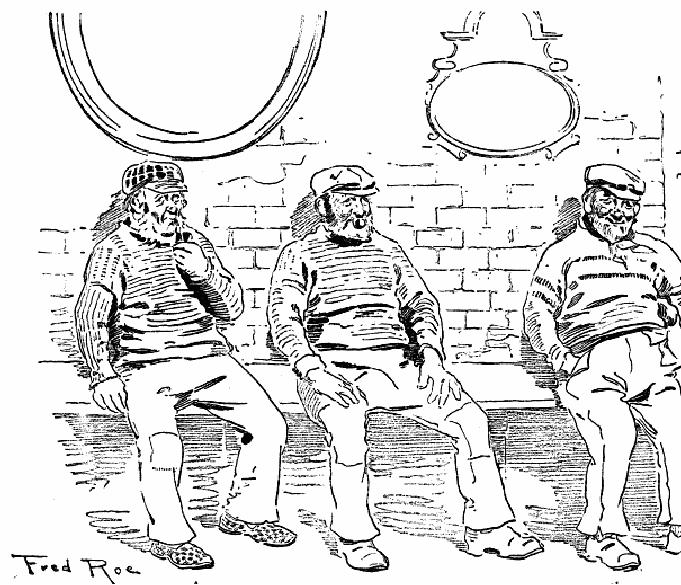
Ancient
Inmates of the Fishermen's
Hospital, Great
Yarmouth
It
is not now the fashion to
found almshouses. We build workhouses
instead, vast
ugly
barracks wherein the poor people
are governed by all the
harsh rules of the
Poor
Law, where husband and wife
are separated from each
other, and "those
whom
God hath joined together
are," by man and the Poor
Law, "put asunder";
where
the industrious labourer is housed
with the lazy and
ne'er-do-weel. The
old
almshouses
were better homes for the
aged poor, homes of rest after
the struggle
for
existence, and harbours of refuge
for the tired and
weary till they embark
on
their
last voyage.
Table of Contents:
- INTRODUCTION
- THE DISAPPEARANCE OF ENGLAND
- OLD WALLED TOWNS
- IN STREETS AND LANES
- OLD CASTLES
- VANISHING OR VANISHED CHURCHES
- OLD MANSIONS
- THE DESTRUCTION OF PREHISTORIC REMAINS
- CATHEDRAL CITIES AND ABBEY TOWNS
- OLD INNS
- OLD MUNICIPAL BUILDINGS
- OLD CROSSES
- STOCKS AND WHIPPING-POSTS
- OLD BRIDGES
- OLD HOSPITALS AND ALMSHOUSES
- VANISHING FAIRS
- THE DISAPPEARANCE OF OLD DOCUMENTS
- OLD CUSTOMS THAT ARE VANISHING
- THE VANISHING OF ENGLISH SCENERY
- CONCLUSION